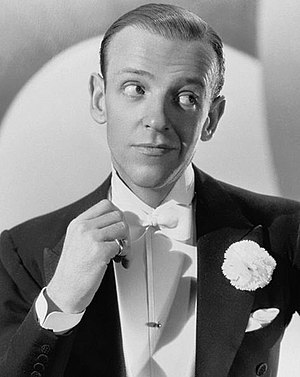Fred Astaire
Fred Astaire (1899 - 1987) was an American movie star best known for his dancing performances. His original name was Frederick Austerlitz.
Astaire started dancing from the age of four. Already in 1906, he formed an act with his sister, Adele. In 1933 he was cast in the Metro-Goldwyn-Mayer production Dancing Lady, which starred Joan Crawford, Clark Gable, and the Three Stooges. Also in 1933 Astaire was paired with Ginger Rogers and they became a sensation. The pair appeared in a classic series of Hollywood movies throughout the 1930s, of which The Gay Divorcee (1934), Top Hat (1935), and Swing Time (1936) were particularly successful.
Astaire retired temporarily in 1946 but returned in 1948 and appeared in a series of film musicals that were regarded as highly as his 1930's work with Ginger Rogers. The best of Astaire's movies during this period was The Band Wagon (1953), often cited as one of the greatest of film musicals.
In addition, Astaire was noted for his singing. Although possessing a rather thin-toned tenor voice, Astaire had a good feel for swing. In the early 1950's, he made some recordings with the Canadian jazz pianist Oscar Peterson.
Astaire's final movie was Ghost Story (1981). He was awarded an honorary Academy Award (an "Oscar") for his contributions in 1950, and he received a Life Achievement Award from the American Film Institute in 1981. In 1959 his autobiography Steps in Time appeared.
He is described as follows:
Lanky figure, Fred incarnates the young worldly, cosmopolitan man, with a slightly detached air but with a hint of arrogance and vivacity. Sophisticated and composed, he is most at ease wearing a tail-coat, with a top hat on his head and in his hand the inevitable cane he uses for his unbridled choreographic performances.[1]
